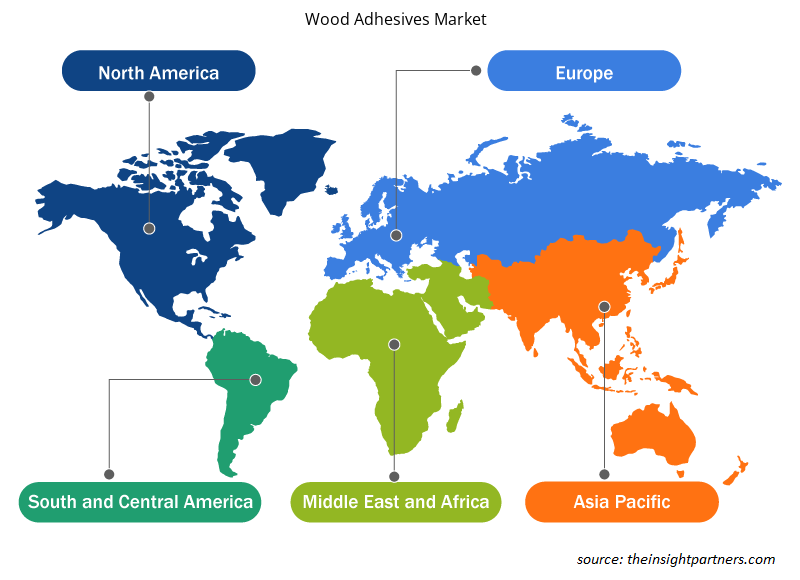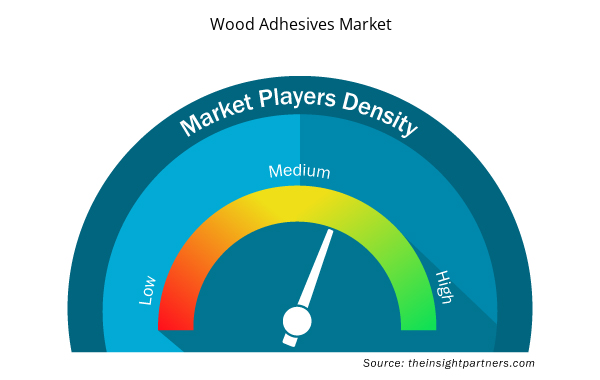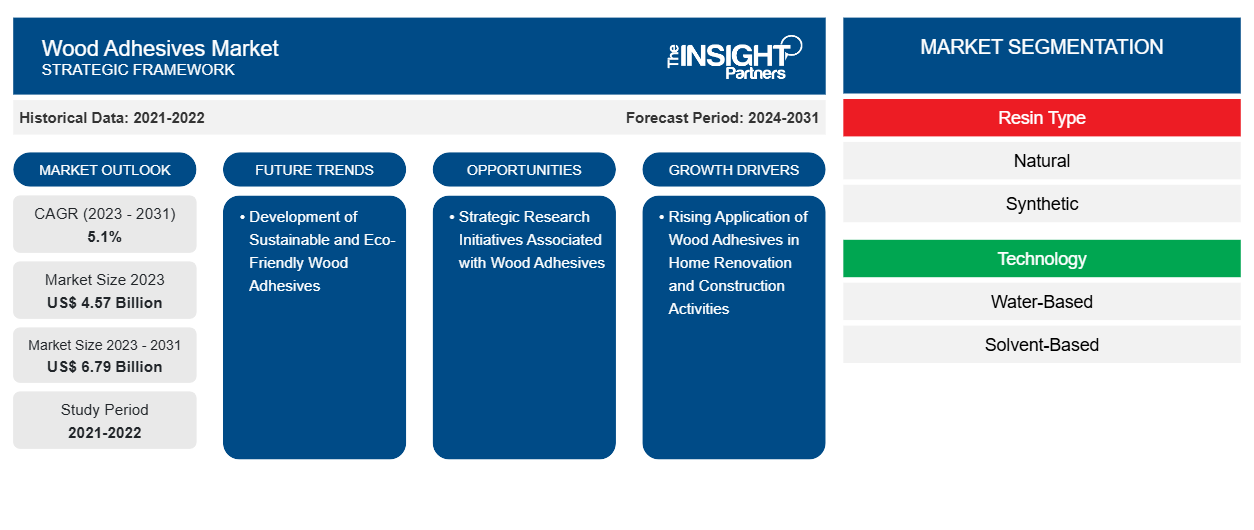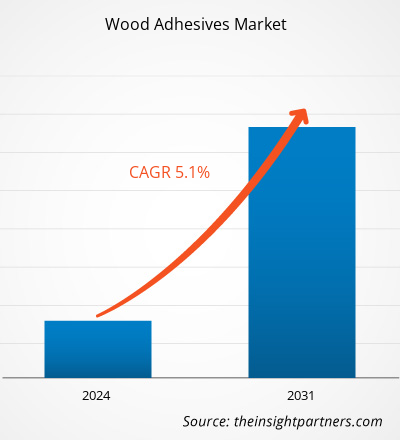Der Markt für Holzklebstoffe soll von 4,57 Milliarden US-Dollar im Jahr 2023 auf 6,79 Milliarden US-Dollar im Jahr 2031 anwachsen. Der Markt wird zwischen 2023 und 2031 voraussichtlich eine durchschnittliche jährliche Wachstumsrate von 5,1 % verzeichnen. Die Entwicklung und Einführung umweltfreundlicher Holzklebstoffe dürfte im Prognosezeitraum neue Trends auf den Markt bringen.
Marktanalyse für Holzklebstoffe
Formaldehyd, Phenol-Formaldehyd, Melamin-Formaldehyd und polymeres Methylendiisocyanat werden zum Verkleben von Holzwerkstoffplatten wie Spanplatten, mittel-/hochdichten Faserplatten, OSB-Platten und Sperrholz verwendet. Der wichtigste Aspekt für den Markt für Klebstoffchemie und -rohstoffe sind die strengen nationalen und internationalen Vorschriften für die Chemieindustrie. Diese Vorschriften sollen die VOC-Werte (flüchtige organische Verbindungen) von Chemikalien begrenzen. Daher wurden die Verwendung, der Export und der Import von Klebstoffen und Polymeren mit hohem VOC-Gehalt in einigen Ländern eingeschränkt. Die wachsende Möbelindustrie, gepaart mit zunehmenden Innovationen auf dem Markt für Holzklebstoffe , dürfte das Marktwachstum begünstigen.
Marktübersicht für Holzklebstoffe
Fortschritte in der chemischen Verfahrenstechnik und Produktionstechnologie haben synthetische Klebstoffe erschwinglicher gemacht, sodass Hersteller Kosten sparen können, ohne Kompromisse bei der Qualität einzugehen. Darüber hinaus werden durch die Entwicklung emissionsarmer und umweltfreundlicher synthetischer Klebstoffe einige der Nachhaltigkeitsbedenken ausgeräumt, die traditionell mit synthetischen Produkten verbunden sind. Die Nachfrage nach lösemittelbasierten Holzklebstoffen steigt aufgrund ihrer außergewöhnlichen Leistungsmerkmale und Vielseitigkeit bei anspruchsvollen Anwendungen. Lösemittelbasierte Klebstoffe bieten starke, dauerhafte Verbindungen, die extrem harten Bedingungen wie hoher Luftfeuchtigkeit, Temperaturschwankungen und der Einwirkung aggressiver Chemikalien standhalten können, was sie ideal für anspruchsvolle industrielle und strukturelle Anwendungen macht.
Passen Sie diesen Bericht Ihren Anforderungen an
Sie erhalten kostenlose Anpassungen an jedem Bericht, einschließlich Teilen dieses Berichts oder einer Analyse auf Länderebene, eines Excel-Datenpakets sowie tolle Angebote und Rabatte für Start-ups und Universitäten.
- Holen Sie sich die wichtigsten Markttrends aus diesem Bericht.Dieses KOSTENLOSE Beispiel umfasst eine Datenanalyse von Markttrends bis hin zu Schätzungen und Prognosen.
Treiber und Chancen auf dem Markt für Holzklebstoffe
Zunehmende Anwendung von Holzklebstoffen bei Renovierungs- und Bautätigkeiten
Holzklebstoffe haben ein breites Anwendungsspektrum, darunter Sperrholz, Möbel, Türen, Fenster und Fußböden . Die wichtigsten Marktteilnehmer bieten wasserbasierte, lösemittelbasierte, EVA-, SBC-, Acryl-, Vinyl-, Epoxid- und Polyurethan-Holzklebstoffe sowie andere Arten von Holzklebstoffen für verschiedene Anwendungen in der Holzindustrie an. Die zunehmende Verwendung von Holzklebstoffen bei Hausrenovierungen und anderen Bautätigkeiten treibt das Marktwachstum an.SBC, acrylic, vinyl, epoxy, and polyurethane, among other types of wood adhesives, for various applications in the woodwork industry. The rising application of wood adhesives in home renovations and other construction activities fuels the market growth.
Strategische Forschungsinitiativen im Zusammenhang mit Holzklebstoffen
Formaldehyd, Phenol-Formaldehyd, Melamin-Formaldehyd und polymeres Methylendiisocyanat werden zur Herstellung von Holzwerkstoffplatten wie Spanplatten, mittel-/hochdichten Faserplatten, OSB-Platten und Sperrholz verwendet. Polyurethan, Phenol-Formaldehyd, Phenol-Resorcin-Formaldehyd, Emulsionspolymerisocyanat, Polyvinylacetat und andere Formulierungschemikalien werden unter anderem für Massivholzlaminierung und Konstruktionsbalken sowie zum Beschichten von Platten mit Furnieren oder Finishfolien verwendet. Wichtige Hersteller auf dem Markt für Holzklebstoffe investieren erheblich in strategische Entwicklungsinitiativen wie Produktinnovation und Forschung und Entwicklung, um ihre Marktposition zu stärken und eine breite Kundenbasis zu gewinnen.methylene diisocyanate are used for the production of wood-based panels, such as particleboard, medium/high-density fiberboard, oriented strand board, and plywood. Polyurethane, phenol-formaldehyde, phenol-resorcinol-formaldehyde, emulsion polymer isocyanate, polyvinyl acetate, and other formulation chemistries are used for solid wood lamination and construction beams and coating of boards with veneers or finish foils, among other applications. Key manufacturers operating in the wood adhesives market invest significantly in strategic development initiatives such as product innovation and research and development to enhance their market position and attract a wide customer base.
Marktbericht zu Holzklebstoffen – Segmentierungsanalyse
Wichtige Segmente, die zur Ableitung der Marktanalyse für Holzklebstoffe beigetragen haben, sind Harztyp, Technologie und Anwendung.
- Basierend auf der Harzart ist der Markt für Holzklebstoffe in natürliche und synthetische unterteilt. Das synthetische Segment hielt im Jahr 2023 einen größeren Marktanteil.
- Technologisch ist der Markt in lösemittelbasierte, wasserbasierte und andere Segmente unterteilt. Das wasserbasierte Segment hielt im Jahr 2023 einen erheblichen Marktanteil.
- Basierend auf der Anwendung wird der Markt für Holzklebstoffe in Möbel , Sperrholz, Fußböden, Türen und Fenster und Sonstiges unterteilt. Das Möbelsegment dominierte den Markt im Jahr 2023.
Marktanteilsanalyse für Holzklebstoffe nach Geografie
Der geografische Umfang des Marktberichts für Holzklebstoffe ist hauptsächlich in fünf Regionen unterteilt: Nordamerika, Asien-Pazifik, Europa, Naher Osten und Afrika sowie Süd- und Mittelamerika.
Europa dominierte den Markt im Jahr 2023. In Europa steigt die Nachfrage nach Holzklebstoffen vor allem aufgrund der Wiederbelebung des Bau- und Immobiliensektors. Da die Urbanisierung fortschreitet und der Bedarf an Wohn-, Gewerbe- und Infrastrukturprojekten wächst, steigt die Nachfrage nach Holzprodukten. Holzklebstoffe sind unverzichtbar für die Herstellung von Holzwerkstoffen wie Sperrholz, Spanplatten und Furnierschichtholz, die aufgrund ihrer Festigkeit und Vielseitigkeit im modernen Bauwesen häufig verwendet werden. Die Präsenz wichtiger Marktteilnehmer, darunter Henkel, Arkema Group und HB Fuller Company, trägt zum Wachstum des Holzklebstoffmarktes bei.Henkel, Arkema Group, and H.B. Fuller Company, among others, contributes to the wood adhesives market growth.
Regionale Einblicke in den Markt für Holzklebstoffe
Die regionalen Trends und Faktoren, die den Markt für Holzklebstoffe im Prognosezeitraum beeinflussen, wurden von den Analysten von Insight Partners ausführlich erläutert. In diesem Abschnitt werden auch die Marktsegmente und die Geografie von Holzklebstoffen in Nordamerika, Europa, im asiatisch-pazifischen Raum, im Nahen Osten und Afrika sowie in Süd- und Mittelamerika erörtert.

- Erhalten Sie regionale Daten zum Holzklebstoffmarkt
Umfang des Marktberichts für Holzklebstoffe
| Berichtsattribut | Details |
|---|---|
| Marktgröße im Jahr 2023 | 4,57 Milliarden US-Dollar |
| Marktgröße bis 2031 | 6,79 Milliarden US-Dollar |
| Globale CAGR (2023 - 2031) | 5,1 % |
| Historische Daten | 2021-2022 |
| Prognosezeitraum | 2024–2031 |
| Abgedeckte Segmente | Nach Harztyp
|
| Abgedeckte Regionen und Länder | Nordamerika
|
| Marktführer und wichtige Unternehmensprofile |
|
Dichte der Marktteilnehmer für Holzklebstoffe: Auswirkungen auf die Geschäftsdynamik verstehen
Der Markt für Holzklebstoffe wächst rasant, angetrieben durch die steigende Nachfrage der Endverbraucher aufgrund von Faktoren wie sich entwickelnden Verbraucherpräferenzen, technologischen Fortschritten und einem größeren Bewusstsein für die Vorteile des Produkts. Mit steigender Nachfrage erweitern Unternehmen ihr Angebot, entwickeln Innovationen, um die Bedürfnisse der Verbraucher zu erfüllen, und nutzen neue Trends, was das Marktwachstum weiter ankurbelt.
Die Marktteilnehmerdichte bezieht sich auf die Verteilung der Firmen oder Unternehmen, die in einem bestimmten Markt oder einer bestimmten Branche tätig sind. Sie gibt an, wie viele Wettbewerber (Marktteilnehmer) in einem bestimmten Marktraum im Verhältnis zu seiner Größe oder seinem gesamten Marktwert präsent sind.
Die wichtigsten auf dem Markt für Holzklebstoffe tätigen Unternehmen sind:
- Henkel AG und Co KGaA
- 3M Co
- Sika AG
- Arkema SA
- Dow Inc
- HB Fuller Company
Haftungsausschluss : Die oben aufgeführten Unternehmen sind nicht in einer bestimmten Reihenfolge aufgeführt.

- Überblick über die wichtigsten Akteure auf dem Markt für Holzklebstoffe
Neuigkeiten und aktuelle Entwicklungen zum Holzklebstoffmarkt
Der Markt für Holzklebstoffe wird durch die Erhebung qualitativer und quantitativer Daten aus Primär- und Sekundärforschung bewertet, die wichtige Unternehmensveröffentlichungen, Verbandsdaten und Datenbanken umfasst. Nachfolgend sind einige der Entwicklungen auf dem Markt für Holzklebstoffe aufgeführt:
- HB Fuller Company gab die Übernahme von ND Industries Inc. bekannt, einem der führenden Anbieter von Spezialklebstoffen sowie Verschluss- und Dichtungslösungen für Kunden in der Automobil-, Elektronik-, Luft- und Raumfahrtindustrie und anderen Branchen. (Quelle: HB Fuller Company, Pressemitteilung, Mai 2024)
- Sika AG gab die Übernahme des Bodenbelagsklebstoffgeschäfts von DriTac bekannt, einem in den USA ansässigen Unternehmen für Bodenbelagsklebstoffe mit einer besonders starken Position im Bereich der Holzbodenverklebung. Die Übernahme wird zur verstärkten Präsenz von Sika AG bei Bodenbelagsinstallateuren und -händlern beitragen und gleichzeitig die Expansion von Sika AG auf dem Markt für Innenausbau in den USA beschleunigen. (Quelle: Sika AG, Pressemitteilung, März 2021)
Marktbericht zu Holzklebstoffen – Umfang und Ergebnisse
Der Bericht „Marktgröße und Prognose für Holzklebstoffe (2021–2031)“ bietet eine detaillierte Analyse des Marktes, die die folgenden Bereiche abdeckt:
- Marktgröße und Prognose für Holzklebstoffe auf globaler, regionaler und Länderebene für alle wichtigen Marktsegmente, die im Rahmen des Berichts abgedeckt sind
- Markttrends für Holzklebstoffe sowie Marktdynamik wie Treiber, Einschränkungen und wichtige Chancen
- Detaillierte Porter's Five Forces Analyse und SWOT-Analyse
- Marktanalyse für Holzklebstoffe mit Blick auf wichtige Markttrends, globale und regionale Rahmenbedingungen, wichtige Akteure, Vorschriften und aktuelle Marktentwicklungen
- Branchenlandschaft und Wettbewerbsanalyse mit Marktkonzentration, Heatmap-Analyse, prominenten Akteuren und jüngsten Entwicklungen auf dem Markt für Holzklebstoffe
- Detaillierte Firmenprofile
- Historische Analyse (2 Jahre), Basisjahr, Prognose (7 Jahre) mit CAGR
- PEST- und SWOT-Analyse
- Marktgröße Wert/Volumen – Global, Regional, Land
- Branche und Wettbewerbsumfeld
- Excel-Datensatz



Report Coverage
Revenue forecast, Company Analysis, Industry landscape, Growth factors, and Trends

Segment Covered
This text is related
to segments covered.

Regional Scope
North America, Europe, Asia Pacific, Middle East & Africa, South & Central America

Country Scope
This text is related
to country scope.
Häufig gestellte Fragen
The wood adhesives market is expected to register a CAGR of 5.1% during 2023–2031.
The wood adhesives market value is estimated to be US$ 6.79 billion by 2031.
Covestro AG, Mitsui Chemicals Inc, Huntsman Corporation, Lubrizol Corporation, and Tosoh Corporation are the leading players operating in the wood adhesives market.
The development of sustainable and eco-friendly wood adhesives is likely to set trends in the upcoming years.
Rapid growth in the furniture industry and a surge in the application of wood adhesives in home renovation and construction activities are among the factors fueling the wood adhesives market growth.
Europe dominated the wood adhesives market in 2023.
Trends and growth analysis reports related to Chemicals and Materials : READ MORE..
The List of Companies - Wood Adhesives Market
- Henkel AG and Co KGaA
- 3M Co
- Sika AG
- Arkema SA
- Dow Inc
- H.B. Fuller Company
- Akzo Nobel NV
- Aica Kogyo Co. Ltd
- Pidilite Industries Ltd
- Mapei SpA
The Insight Partners performs research in 4 major stages: Data Collection & Secondary Research, Primary Research, Data Analysis and Data Triangulation & Final Review.
- Data Collection and Secondary Research:
As a market research and consulting firm operating from a decade, we have published and advised several client across the globe. First step for any study will start with an assessment of currently available data and insights from existing reports. Further, historical and current market information is collected from Investor Presentations, Annual Reports, SEC Filings, etc., and other information related to company’s performance and market positioning are gathered from Paid Databases (Factiva, Hoovers, and Reuters) and various other publications available in public domain.
Several associations trade associates, technical forums, institutes, societies and organization are accessed to gain technical as well as market related insights through their publications such as research papers, blogs and press releases related to the studies are referred to get cues about the market. Further, white papers, journals, magazines, and other news articles published in last 3 years are scrutinized and analyzed to understand the current market trends.
- Primary Research:
The primarily interview analysis comprise of data obtained from industry participants interview and answers to survey questions gathered by in-house primary team.
For primary research, interviews are conducted with industry experts/CEOs/Marketing Managers/VPs/Subject Matter Experts from both demand and supply side to get a 360-degree view of the market. The primary team conducts several interviews based on the complexity of the markets to understand the various market trends and dynamics which makes research more credible and precise.
A typical research interview fulfils the following functions:
- Provides first-hand information on the market size, market trends, growth trends, competitive landscape, and outlook
- Validates and strengthens in-house secondary research findings
- Develops the analysis team’s expertise and market understanding
Primary research involves email interactions and telephone interviews for each market, category, segment, and sub-segment across geographies. The participants who typically take part in such a process include, but are not limited to:
- Industry participants: VPs, business development managers, market intelligence managers and national sales managers
- Outside experts: Valuation experts, research analysts and key opinion leaders specializing in the electronics and semiconductor industry.
Below is the breakup of our primary respondents by company, designation, and region:

Once we receive the confirmation from primary research sources or primary respondents, we finalize the base year market estimation and forecast the data as per the macroeconomic and microeconomic factors assessed during data collection.
- Data Analysis:
Once data is validated through both secondary as well as primary respondents, we finalize the market estimations by hypothesis formulation and factor analysis at regional and country level.
- Macro-Economic Factor Analysis:
We analyse macroeconomic indicators such the gross domestic product (GDP), increase in the demand for goods and services across industries, technological advancement, regional economic growth, governmental policies, the influence of COVID-19, PEST analysis, and other aspects. This analysis aids in setting benchmarks for various nations/regions and approximating market splits. Additionally, the general trend of the aforementioned components aid in determining the market's development possibilities.
- Country Level Data:
Various factors that are especially aligned to the country are taken into account to determine the market size for a certain area and country, including the presence of vendors, such as headquarters and offices, the country's GDP, demand patterns, and industry growth. To comprehend the market dynamics for the nation, a number of growth variables, inhibitors, application areas, and current market trends are researched. The aforementioned elements aid in determining the country's overall market's growth potential.
- Company Profile:
The “Table of Contents” is formulated by listing and analyzing more than 25 - 30 companies operating in the market ecosystem across geographies. However, we profile only 10 companies as a standard practice in our syndicate reports. These 10 companies comprise leading, emerging, and regional players. Nonetheless, our analysis is not restricted to the 10 listed companies, we also analyze other companies present in the market to develop a holistic view and understand the prevailing trends. The “Company Profiles” section in the report covers key facts, business description, products & services, financial information, SWOT analysis, and key developments. The financial information presented is extracted from the annual reports and official documents of the publicly listed companies. Upon collecting the information for the sections of respective companies, we verify them via various primary sources and then compile the data in respective company profiles. The company level information helps us in deriving the base number as well as in forecasting the market size.
- Developing Base Number:
Aggregation of sales statistics (2020-2022) and macro-economic factor, and other secondary and primary research insights are utilized to arrive at base number and related market shares for 2022. The data gaps are identified in this step and relevant market data is analyzed, collected from paid primary interviews or databases. On finalizing the base year market size, forecasts are developed on the basis of macro-economic, industry and market growth factors and company level analysis.
- Data Triangulation and Final Review:
The market findings and base year market size calculations are validated from supply as well as demand side. Demand side validations are based on macro-economic factor analysis and benchmarks for respective regions and countries. In case of supply side validations, revenues of major companies are estimated (in case not available) based on industry benchmark, approximate number of employees, product portfolio, and primary interviews revenues are gathered. Further revenue from target product/service segment is assessed to avoid overshooting of market statistics. In case of heavy deviations between supply and demand side values, all thes steps are repeated to achieve synchronization.
We follow an iterative model, wherein we share our research findings with Subject Matter Experts (SME’s) and Key Opinion Leaders (KOLs) until consensus view of the market is not formulated – this model negates any drastic deviation in the opinions of experts. Only validated and universally acceptable research findings are quoted in our reports.
We have important check points that we use to validate our research findings – which we call – data triangulation, where we validate the information, we generate from secondary sources with primary interviews and then we re-validate with our internal data bases and Subject matter experts. This comprehensive model enables us to deliver high quality, reliable data in shortest possible time.


 Holen Sie sich ein kostenloses Muster für diesen Bericht
Holen Sie sich ein kostenloses Muster für diesen Bericht